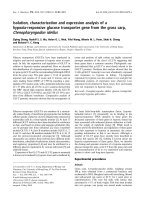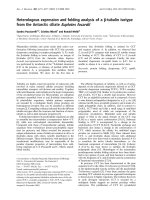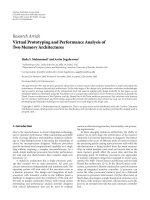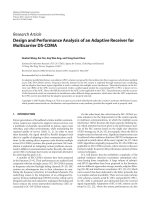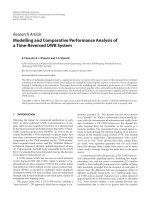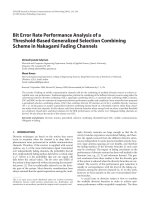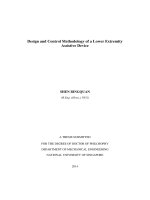Design, simulation, fabrication and performance analysis of a piezoresistive micro accelerometer
Bạn đang xem bản rút gọn của tài liệu. Xem và tải ngay bản đầy đủ của tài liệu tại đây (1.55 MB, 126 trang )
CONTENTS
Declaration
Abbreviation & Notations
List of Tables
List of Figures and Graphs
CHAPTER 1.............................................................................................................. 2
INTRODUCTION .................................................................................................... 2
1.1 Motivation and Objectives of This Thesis ........................................................ 2
1.2 Overview of MEMS ............................................................................................ 3
1.3 Reviews on Silicon Micro Accelerometers ....................................................... 4
1.4 Reviews on Development of Multi-Axis Accelerometers ................................ 7
1.5 Reviews on Performance Optimization of Multi-Axis Accelerometers ...... 10
1.6 Content of the Thesis ........................................................................................ 12
CHAPTER 2............................................................................................................ 14
TRENDS
IN
DESIGN
CONCEPTS
FOR
MEMS:
APPLIED
FOR
PIEZORESISTIVE ACCELEROMETER .......................................................... 14
2.1 Open-loop Accelerometers............................................................................... 14
2.2 Piezoresistive Accelerometer ........................................................................... 21
2.3 Overview of MNA and FEM Softwares ......................................................... 35
2.4 Summary ........................................................................................................... 41
CHAPTER 3............................................................................................................ 42
DESIGN PRINCIPLES AND ILLUSTRATING APPLICATION: A 3-DOF
ACCELEROMETER ............................................................................................. 42
3.1 Introductions ..................................................................................................... 42
3.2 Working Principle for a 3-DOF Accelerometers ........................................... 42
3.3 A Systematic and Efficient Approach of Designing Accelerometers........... 44
3.4 Structure Analysis and the Design of the Piezoresistive Sensor .................. 52
3.5 Measurement Circuits ...................................................................................... 57
3.6 Multiphysic Analysis of the 3-DOF Accelerometer ....................................... 61
Design, Simulation, Fabrication and Performance Analysis of a Piezoresistive
Micro Accelerometer
3.7 Noise Analysis ................................................................................................... 68
3.8 Mask Design ...................................................................................................... 72
3.9 Summary ........................................................................................................... 77
CHAPTER 4............................................................................................................ 79
FABRICATION AND CALIBRATION OF THE 3-DOF ACCELEROMETER
.................................................................................................................................. 79
4.1 Fabrication Process of the Acceleration Sensor ............................................ 79
4.2 Measurement Results ....................................................................................... 89
4.3 Summary ......................................................................................................... 100
CHAPTER 5.......................................................................................................... 101
OPTIMIZATION BASED ON FABRICATED SENSOR ............................... 101
5.1 Introductions ................................................................................................... 101
5.2 Pareto Optimality Processes .......................................................................... 101
5.3 Summary ......................................................................................................... 110
CONCLUSIONS ................................................................................................... 111
Design, Simulation, Fabrication and Performance Analysis of a Piezoresistive
Micro Accelerometer
CHAPTER 1
INTRODUCTION
1.1 Motivation and Objectives of This Thesis
During the last decades, MEMS technology has undergone rapid development,
leading to the successful fabrication of miniaturized mechanical structures
integrated with microelectronic components. Accelerometers are in great demand
for specific applications ranging from guidance and stabilization of spacecrafts to
research on vibrations of Parkinson patients’ fingers. Generally, it is desirable that
accelerometers exhibit a linear response and a high signal-to-noise ratio. Among the
many technological alternatives available, piezoresistive accelerometers are
noteworthy. They suffer from dependence on temperature, but have a DC response,
simple readout circuits, and are capable of high sensitivity and reliability. In
addition, this low-cost technology is suitable for multi degrees-of-freedom
accelerometers which are high in demand in many applications.
In order to commercialize MEMS products effectively, one of the key factors is the
streamlining of the design process. The design flow must correctly address design
performance specifications prior to fabrication. However, CAD tools are still scarce
and poorly integrated when it comes to MEMS design. One of the goals of this
thesis is to outline a fast design flow in order to reach multiple specified
performance targets in a reasonable time frame. This is achieved by leveraging the
best features of two radically different simulation tools: Berkeley SUGAR, which is
an open-source academic effort, and ANSYS, which is a commercial product.
There is an extensive research on silicon piezoresistive accelerometer to improve its
performance and further miniaturization. However, a comprehensive analysis
considering the impact of many parameters, such as doping concentration,
temperature, noises, and power consumption on the sensitivity and resolution has
not been reported. The optimization process for the 3-DOF micro accelerometer
Design, Simulation, Fabrication and Performance Analysis of a Piezoresistive
Micro Accelerometer
which is based on these considerations has been proposed in this thesis in order to
enhance the sensitivity and resolution.
1.2 Overview of MEMS
Microelectromechanical systems (MEMS) are collection of micro sensors and
actuators that sense the environment and react to changes in that environment [46].
They also include the control circuit and the packaging. MEMS may also need
micro-power supply and micro signal processing units. MEMS make the system
faster, cheaper, more reliable, and capable of integrating more complex functions
[5].
In the beginning of 1990s, MEMS appeared with the development of integrated
circuit (IC) fabrication processes. In MEMS, sensors, actuators, and control
functions are co-fabricated in silicon. The blooming of MEMS research has been
achieved under the strong promotions from both government and industries. Beside
some less integrated MEMS devices such as micro-accelerometers, inkjet printer
head, micro-mirrors for projection, etc have been in commercialization; more and
more complex MEMS devices have been proposed and applied in such varied fields
as microfluidics, aerospace, biomedical, chemical
communications, data storage, display, optics, etc.
analysis,
wireless
At the end of 1990s, most of MEMS transducers were fabricated by bulk
micromachining, surface micromachining, and LIthography, GAlvanoforming,
moulding (LIGA) processes [7]. Not only silicon but some more materials have
been utilized for MEMS. Further more, three-dimensional micro-fabrication
processes have been applied due to specific application requirements (e.g.,
biomedical devices) and higher output power micro-actuators.
Micro-machined inertial sensors that consist of accelerometers and gyroscopes have
a significant percentage of silicon based sensors. The accelerometer has got the
second largest sales volume after pressure sensor [56]. Accelerometer can be found
mainly in automotive industry [62], biomedical application [30], household
electronics [69], robotics, vibration analysis, navigation system [59], and so on.
Design, Simulation, Fabrication and Performance Analysis of a Piezoresistive
Micro Accelerometer
Various kinds of accelerometer have increased based on different principles such as
capacitive, piezoresistive, piezoelectric, and other sensing ones [22]. The concept of
accelerometer is not new but the demand from commerce has motivated continuous
researches in this kind of sensor in order to minimize the size and improve its
performance.
1.3 Reviews on Silicon Micro Accelerometers
Silicon acceleration sensors often consist of a proof mass which is suspended to a
reference frame by spring elements. Accelerations cause the proof mass to deflect
and the deflection of the mass is proportional to the acceleration. This deflection
can be measured in several ways, e.g. capacitively by measuring a change in
capacitance between the proof mass and additional electrodes or piezoresistively by
integrating strain gauges in the spring element. The bulk micromachined techniques
have been utilized to obtain large sensitivity and low noise.
However, surface micromachined is more attractive because of the easy integration
with electronic circuits and no need of using wafer bonding as that of bulk
micromachining. Recently, some structures have been proposed which combine
bulk and surface micromachining to obtain a large proof mass in a single wafer
process.
To classify the accelerometer, we can use several ways such as mechanical or
electrical, active or passive, deflection or null-balance accelerometers, etc.
This thesis reviewed following type of the accelerometers [67]:
Electromechanical
Piezoelectric
Piezoresistive
Capacitive
Resonant accelerometer
Depending on the principles of operations, these accelerometers have their own
subclasses.
1.3.1 Electromechanical Accelerometers
Design, Simulation, Fabrication and Performance Analysis of a Piezoresistive
Micro Accelerometer
There are a number of different electromechanical accelerometers: coil-andmagnetic types, induction types, etc. In these sensors, a proof mass is kept very
close to a neutral position by sensing the deflection and feeding back the effect of
this deflection. A corresponding magnetic force is generated to eliminate the motion
of the proof mass deflected from the neutral position, thus restoring this position
like the way a mechanical spring in a conventional accelerometer would do. This
approach can offer a better linearity and elimination of hysteresis effects when
compare to the mechanical springs [21].
1.3.2 Piezoelectric Accelerometers
Piezoelectric accelerometers are suitable for high-frequency applications and shock
measurement. They can offer large output signals, small sizes and no need of
external power sources [53]. These sensors utilize a proof mass in direct contact
with the piezoelectric component as shown in Fig 1. 1. There are two common
piezoelectric crystals are lead- zirconate titanate ceramic (PZT) and crystalline
quartz. When an acceleration is applied to the accelerometer, the piezoelectric
component experiences a varying force excitation (F = ma), causing a proportional
electric charge q to be developed across it. The disadvantage of this kind of
accelerometer is that it has no DC response.
Fig 1. 1 A compression type piezoelectric accelerometer arrangement.
1.3.3 Piezoresistive Accelerometers
Piezoresistive accelerometers (see Fig 1. 2) have held a large percentage of solidstate sensors [79],[83]. The reason is that they have a DC response, simple readout
circuits, and are capable of high sensitivity and reliability even if they suffer from
dependence on temperature. In addition, it is a low-cost technology suitable for
Design, Simulation, Fabrication and Performance Analysis of a Piezoresistive
Micro Accelerometer
high-volume production. The operational principle is based on piezoresistive effect
where the conductivity would change due to an applied strain. Piezoresistive
accelerometers are useful for static acceleration measurements and vibration
analysis at low frequencies. The sensing elements are piezoresistors which forms
Wheatstone bridge to obtain the voltage output without extra electronic circuits.
Fig 1. 2 Piezoresistive acceleration sensor.
1.3.4 Capacitive Accelerometers
Capacitive accelerometers are based on the principle of the change of capacitance in
proportion to applied acceleration. Depending on the operation principles and
external circuits they can be broadly classified as electrostatic-force-feedback
accelerometers, and differential-capacitance accelerometers (see Fig 1. 3) [37].
Fig 1. 3 Capacitive measurement of acceleration.
The proof mass carries an electrode placed in opposition to base-fixed electrodes
that define variable capacitors. By applying acceleration, the seismic mass of the
accelerometer is deflected, leading to capacitive changes. These kinds of
accelerometer require wire connecting to external circuits which in turn experience
Design, Simulation, Fabrication and Performance Analysis of a Piezoresistive
Micro Accelerometer
parasitic capacitances. The advantages of capacitive sensors are high sensitivity,
low power consumption and low temperature dependence.
1.3.5 Resonant Accelerometers
The structures of resonant accelerometers are quite different from other sensors (see
Fig 1. 4). The proof mass is suspended by stiff beam suspension to prevent large
deflection due to large acceleration. By applying acceleration, the proof mass
changes the strain in the attached resonators, leading a shift in those resonant
frequencies. The frequency shift is then detected by either piezoresistive, capacitive
or optical readout methods and the output can be measured easily by digital
counters.
Fig 1. 4 Resonant accelerometer
Resonant accelerometers provide high sensitivity and frequency output. However,
the use of complex circuit containing oscillator is a competitive approach for high
precision sensing in long life time.
1.4 Reviews on Development of Multi-Axis Accelerometers
As we know, the realistic applications create a huge motivation for the widely
research of MEMS based sensors, especially accelerometer. In this modern world,
applications require new sensors with smaller size and higher performance
[1],[12],[57]. In practice, there are rare researches which can bring out an efficient
and comprehensive methodology for accelerometer designs.
Design, Simulation, Fabrication and Performance Analysis of a Piezoresistive
Micro Accelerometer
T.Mineta et al [68] presents design, fabrication, and calibration of a 3-DOF
capacitive acceleration which has uniform sensitivities to three axes. However, this
sensor is more complex than piezoresistive one and is not economical to fabricate
with MEMS technology.
In 2004, Dzung Viet Dao et al [16] presented the characterization of nanowire ptype Si piezoresistor, as well as the design of an ultra small 3-DOF accelerometer
utilizing the nanowire Si piezoresistor. Silicon nanowire piezoresistor could
increase the longitudinal piezoresistance coefficient πl [011] of the Si nanowire
piezoresistor up to 60% with a decrease in the cross sectional area, while transverse
piezoresistance coefficient πt [011] decreased with an increase in the aspect ratio of
the cross section. Thus, the sensitivity of the sensor would be enhanced.
In 1996, Shin-ogi et al [60] presented an acceleration sensor fabricated on a
piezoresistive element with other necessary circuits and runs parallel to the direction
of acceleration. The accelerometer utilizes lateral detection to obtain good
sensitivity and small size. The built-in amplifier has been formed with a narrow
width, and confirmed operation.
In 1998, Kruglick E.J.J et al [40] presented a design, fabrication, and testing of
multi-axis CMOS piezoresistive accelerometers. The operation principle is based on
the piezoresistive behavior of the gate polysilicon in standard CMOS (see Fig 1. 5).
Built-in amplifiers were designed and built on chip and have been characterized.
Design, Simulation, Fabrication and Performance Analysis of a Piezoresistive
Micro Accelerometer
Fig 1. 5 Overview of accelerometer design.
In 2006, Dzung Viet Dao et al [17] presented the development of a dual axis
convective accelerometer (see Fig 1. 6). The working principle of this sensor is
based on the convective heat transfer and thermo-resistive effect of lightly-doped
silicon. This accelerometer utilizes novel structures of the sensing element which
can reduce 93% of thermal-induced stress. Instead of the seismic mass, the
operation of the accelerometer is based on the movement of a hot tiny fluid bubble
from a heater in a hermetic chamber. Thus, it can overcome the disadvantages of the
ordinary "mechanical" accelerometers such as low shock resistance and complex
fabrication process.
Design, Simulation, Fabrication and Performance Analysis of a Piezoresistive
Micro Accelerometer
Fig 1. 6 Schematic view shows working principle of the sensor
1.5 Reviews on Performance Optimization of Multi-Axis Accelerometers
In fact, there are lacks of researches focusing to optimize the multi-axis
accelerometer’s performance.
In 1997, J. Ramos [32] presented a lateral capacitive structure that could enhance
the sensitivity by width optimization. An optimum assignment is found for the
distribution of area in surface micromachined lateral capacitive accelerometers
between stationary and moving of the sensor.
In 2000, Harkey J.A et al [27] presented 1/f noise considerations for the design and
process optimization of piezoresistive cantilevers. In this paper, data was shown
which validates the Hooge model for 1/f noise in piezoresistive cantilevers. From
equations for the Hooge noise, Johnson noise, and sensitivity, an expression was
derived to predict force resolution of a piezoresistive cantilever based on its
geometry and processing. Using this expression, an optimization analysis was
performed.
Design, Simulation, Fabrication and Performance Analysis of a Piezoresistive
Micro Accelerometer
In 2004, Sankar et al [58] presents temperature drift analysis of silicon
micromachined peizoresistive accelerometer. The result is quite simple in terms of
the variation of the output voltage at different accelerations and temperatures. The
optimization targets have not mentioned in this paper yet.
In 2006, Maximillian Perez and Andrei M. Shkel [44] focused on the detailed
analysis of a single sensor of such a series and evaluates the performance trade-offs.
This work provides tools required to characterize and demonstrate the capabilities
of transmission-type intrinsic Fabry-Perot accelerometers. This sensor is more
complex than piezoresistive one and it can only sense acceleration in one
dimension.
In 2006, C Pramanik et al [4] presented the design optimization of high
performance conventional silicon-based pressure sensors on flat diaphragms for
low-pressure biomedical applications have been achieved by optimizing the doping
concentration and the geometry of the piezoresistors. A new figure of merit called
the performance factor (PF) is defined as the ratio of the product of sensor
sensitivity (S) and sensor signal-to-noise ratio (SNR) to the temperature coefficient
of piezoresistance (TCPR). PF has been introduced as a quantitative index of the
overall performance of the pressure sensor for low-range biomedical applications.
In 2002, Rodjegard H. et al [55] presented analytical models for three axis
accelerometers based on four seismic masses. The models make it possible to better
understand and to predict the behavior of these accelerometers. Cross-axis
sensitivity, resolution, frequency response and direction dependence are
investigated for variety of sensing element structures and readout methods. With the
maximum sensitivity direction of the individual sensing elements inclined 35.3o
with respect to the chip surface the properties become direction independent, i.e.
identical resolution and frequency response in all directions.
In 2005, Zhang Y. et al [80] presented a hierarchical MEMS synthesis and
optimization architecture has been developed for MEMS design automation. The
architecture integrates an object-oriented component library with a MEMS
simulation tool and two levels of optimization: global genetic algorithms and local
gradient-based refinement. Surface micro-machined suspended resonators are used
as an example to introduce the hierarchical MEMS synthesis and optimization
process.
Design, Simulation, Fabrication and Performance Analysis of a Piezoresistive
Micro Accelerometer
In 2007, Xin Zhao et al [85] presented a novel MEMS design methodology that
combined with top-down and bottom-up conceptions. Besides, Virtual Fabrication
Process and Virtual Operation are also utilized in the design process which could
exhibit 3D realistic image and real-time animation of microfluidic device. IP
(Intellectual Property) library is established to support hybrid top-down and bottomup design notions. Also an integrated MEMS CAD composed of these design ideas
is developed. However, the optimization considerations have not been concerned in
this method yet and it seemed to be time-consuming works.
1.6 Content of the Thesis
The thesis consists of 5 chapters.
Chapter 1 gives a thorough review on motivation of the thesis, silicon
accelerometers, multi-axis acceleration sensors, and optimization problems in
MEMS sensor’s designs.
Chapter 2 presents fundamental principle of open loop accelerometer and the
piezoresistance effect in silicon. This kind of phenomena is later used for designing
of the 3-DOF acceleration sensor. Principles of FEM and MNA methods are also
described in order to perform structure optimum in the next chapter.
In Chapter 3, a hierarchical MEMS design synthesis and optimization process are
developed for and validated by the design of a specific MEMS accelerometer. The
iterative synthesis design is largely based on the use of a MNA tool called SUGAR
in order to meet multiple design specifications. After some human interactions, the
design is brought to FEM software such as ANSYS for final validation and further
optimization (such as placement of the piezoresistors in our case study).
The structural analysis, a very important step that can provide the stress distribution
on the beams, is presented in the next section. The chapter 3 also describes more
details of the design that multi-physic coupling for thermal–mechanical–
piezoresistive fields was established in order to evaluate the sensor characteristics.
The design of the photo masks is mentioned at last.
Chapter 4 presents the whole process to fabricate the 3-DOF MEMS based
accelerometers. After that, static and dynamic measurements have been performed
on these sensors. The Allan variance method was combined with the Power
spectrum density (PSD) to specify the error parameters of the sensor and electronic
circuit.
Design, Simulation, Fabrication and Performance Analysis of a Piezoresistive
Micro Accelerometer
Chapter 5 presents the design optimization for a high performance 3-DOF silicon
accelerometer. The target is to achieve the high sensitivity or high resolution. The
problem has been solved based on considerations of junction depth, the doping
concentration of the piezoresistor, the noise, and the power consumption. The result
shows that the sensitivity of the optimized accelerometer is improved while the
resolution is small compared to previous experimental results.
Design, Simulation, Fabrication and Performance Analysis of a Piezoresistive
Micro Accelerometer
CHAPTER 2
TRENDS IN DESIGN CONCEPTS FOR MEMS: APPLIED FOR
PIEZORESISTIVE ACCELEROMETER
2.1 Open-loop Accelerometers
The operational principle of an accelerometer is based on the Newton’s second law.
Upon acceleration, the proof mass (seismic mass) that is anchored on the frame by
mechanical suspensions experiences an inertial force F (= -ma) causing a deflection
of the proof mass, where a is the frame acceleration. Under certain conditions, the
displacement is proportional to the input acceleration:
x=
ma
k
(2.1)
where k is the spring constant of the suspension. The displacement can be
detected and converted into an electrical signal by several sensing techniques. This
simple principle underlies the operation of all accelerometers.
From a system point of view, there are two major classes of silicon microaccelerometers: open-loop and force-balanced accelerometers [48]. In open-loop
accelerometer design, the suspended proof mass displaces from its neutral position
and the displacement is measured either piezoresistively or capacitively. In forcebalance accelerometer design, a feedback force, typically an electrostatic force, is
applied onto the proof mass to counteract the displacement caused by the inertial
force. Hence, the proof mass is virtually stationary relative to the frame. The output
signal is proportional to the feedback signal.
In this section, the behavior of only open-loop accelerometers will be described and
its steady state, frequency, and transition response will be studied analytically. The
force-balanced accelerometers are not the subject of this thesis. The reason is that
this thesis intends to focus to the piezoresistive sensing method which is applied
mainly for the open-loop accelerometer type, whereas in the force balanced one the
capacitive sensing method is needed to be used.
Design, Simulation, Fabrication and Performance Analysis of a Piezoresistive
Micro Accelerometer
An open-loop accelerometer can be modeled as a proof mass suspended elastically
on a frame, as shown in Fig 2. 1. The frame is attached to the object whose
acceleration is to be measured. The proof mass moves from its neutral position
relative to the frame when the frame starts to accelerate. For a given acceleration,
the proof mass displacement is determined by the mechanical suspension and the
damping.
Fig 2. 1 Model of the open loop accelerometer
As shown in Fig 2. 1, y and z are the absolute displacement (displacement with
respect to the earth) for the frame and the proof mass, respectively. The acceleration
y is the quantity of the interest in the measurement of this sensor. Let x be the
relative displacement of the proof mass with respect to the frame, its value is the
difference between the absolute displacements of the frame and the proof mass, or
x = z – y.
In the following analysis, the displacement refers to the relative displacement of the
proof mass to the frame (x) in one-dimensional problems, unless otherwise
specified. In the three dimensional problems, y and z will denote the relative
displacements in the remain coordinate axes, y and z, respectively. We also note
that the lower cases x, y, and z denote the displacement in the time domain, whereas
the upper cases X, Y. and Z are respectively their Laplace transforms in the sdomain.
Let’s go back to the one dimensional problem of Fig. 2.1, when the inertial force
displaces the proof mass, it also experiences the restoring force from the mechanical
spring and the damping force from the viscous damping. Since the proof mass is
Design, Simulation, Fabrication and Performance Analysis of a Piezoresistive
Micro Accelerometer
usually sealed in the frame, the damping force is proportional to the velocity
relative to the frame, rather than to the absolute velocity. The equation of motion of
the proof mass can be thus written as:
m
d 2z
dx
= − kx − b
2
dt
dt
(2.2)
where k is the spring constant of the suspension and b is the damping
coefficient of the air and any other structural damping (see Fig. 2.1).
Using x=z-y the following equation of motion can be obtained:
d 2 x b dx k
d2y
+
+
x
=
−
= − a (t )
dt 2 m dt m
dt 2
(2.3)
The negative sign indicates that the displacement of the proof mass is always in the
opposite direction of the acceleration. Equation (2.3) can also be re-written as:
d 2x
dx
d2y
2
2
ξω
ω
x
+
+
=
−
n
n
dt
dt 2
dt 2
where ω n =
(2.4)
k
b
is natural resonant frequency, ξ =
is damping factor.
m
2mω n
This is the governing equation for an open loop accelerometer relating its proof
mass displacement and the input acceleration. The performance of an open-loop
accelerometer can be characterized by the natural resonant frequency ωn and the
damping factor ζ. The damping is determined by the viscous liquid or the chamber
pressure. For silicon micro accelerometers, gas damping is most commonly used
and the damping factor is controlled by the chamber pressure and the gas properties.
Critical damping is desired in most designs in order to achieve maximum bandwidth
and minimum overshoot and ringing.
The natural resonant frequency is another important parameter in an open loop
accelerometer design. It is designed to satisfy the requirements on the sensitivity
and the bandwidth. The natural resonant frequency can be measured either
dynamically by resonating the accelerometer or statically by measuring the
displacement for a given acceleration. From its definition, the natural resonant
frequency can be re-written as:
ωn =
k
=
m
a
x
(2.5)
Design, Simulation, Fabrication and Performance Analysis of a Piezoresistive
Micro Accelerometer
where a is the acceleration and x is the displacement. Therefore, the natural
resonant frequency can be determined conveniently by measuring the displacement
due to the gravitational field.
Steady-State Response: For a constant acceleration, the proof mass is stationa1y
relative to the frame so that equation (2.4) becomes:
d2y
ω x = − 2 = −a
dt
2
n
(2.6)
or
x=−
m
a
k
(2.7)
The static sensitivity of the accelerometer is shown to be:
x m
1
= = 2
a k ωn
(2.8)
Therefore, the proof mass displacement is linearly proportional to the input
acceleration in the steady state. The sensitivity is determined by the ratio m/k or the
inverse of the square of natural resonant frequency. Hence, the resonance frequency
of the structure can be increased by increasing the spring constant and decreasing
the proof mass, while the quality factor of the device can be increased by reducing
damping and by increasing proof mass and spring constant. Last, the static response
of the device can be improved by reducing its resonant frequency.
Fig 2. 2 shows the SIMULINK model of an open loop accelerometer which was
derived from the mechanical simulation of the accelerometer presented in Fig 2. 1.
This high level model can be utilized to analyze the frequency and transient
responses of the sensor.
Design, Simulation, Fabrication and Performance Analysis of a Piezoresistive
Micro Accelerometer
Fig 2. 2 The SIMULINK model of the open-loop accelerometer
Frequency Response: Frequency response is the acceleration response to a
sinusoidal excitation. Let the frame be in harmonic motion
d2y
a(t ) = 2 = −Yω 2 sin ωt
dt
(2.9)
Note that magnitude of accelerator is − Yω 2 . The motion governing equation, eq 2.4
becomes:
d 2x
dx
+ 2ξω n
+ ω n2 x = Yω 2 sin ωt
2
dt
dt
(2.10)
The frequency response can be obtained by solving this equation either in the time
domain or in the s-domain using Laplace transforms. To solve it in the time domain,
assuming that the initial velocity and displacement are both zero, we can transform
equation (2.10) into s domain and obtain:
X (s ) =
(s
2
+ω2
Yω 3
s 2 + 2ξω n s + ω n2
)(
)
(2.11)
The frequency response in the time domain can be obtained by applying invert
Laplace transforms to equation (2.11)
x(t ) = −
Yω 2
ω
where φ is phase lag and:
2
n
sin (ωt − φ )
ω2
1 − 2
ωn
2
ω
+ 2ξ
ωn
2
(2.12)
Design, Simulation, Fabrication and Performance Analysis of a Piezoresistive
Micro Accelerometer
2ξ
tan φ =
ω
ωn
ω
1 −
ωn
(2.13)
2
The sensitivity of an accelerometer can be defined as
S ( jω ) =
X ( jω )
a ( jω )
.
Substituting jω for s in equation (2.11), the amplitude response can be plotted with
various damping coefficients and is presented in Fig 2. 3(a). It shows that there are
big overshoot and ringing for under-damped accelerometers, and the cut-off
frequency for over-damped accelerometers is lower than for critically damped
accelerometers. The phase lag φ can also be plotted for various damping
coefficients, as shown in the Fig. 2.3 (b). The experimental result on critical
damping control can be found in [72].
At low frequency (ω << ω n ) , we can obtain S 0 = −ω n−2 = −
m
from equation (2.12),
k
which agrees with the steady state response state (equation 2.7). At high
frequency (ω >> ω n ) , the mechanical spring cannot respond to the high frequency
vibration and relax its elastic energy. Therefore, for a given acceleration, the proof
mass displacement decrease as the frequency increases. From equation (2.12), we
can obtain S ( jω ) = −
ω2
ω
so the slope of the asymptote is − 2 at high frequencies.
ωn
ωn
Design, Simulation, Fabrication and Performance Analysis of a Piezoresistive
Micro Accelerometer
Fig 2. 3 Frequency response with various damping coefficient b
The accelerometer can also be used to measure velocity and displacement in
addition to acceleration, although the velocity measurements using accelerometers
have very limited applications. The displacement is proportional to the acceleration
when the frequency is below a natural resonant frequency, as shown in Fig 2. 3. The
accelerometer therefore can be used as a vibro-meter (or displacement meter) for
frequencies well above the resonant frequency. From equation (2.12), we find that
ω 2 sin (ωt − φ )
x(t )
m
=−
2
Y
k
ω2 ω
1 − 2 + 2ξ
ωn ωn
2
(2.14)
In other words, the response of the vibrometer is the ratio of the vibration amplitude
of the proof mass and the amplitude of applied vibration.
Similar to the analysis for the frequency response, we can obtain the transient
response in the time domain:
Design, Simulation, Fabrication and Performance Analysis of a Piezoresistive
Micro Accelerometer
e −ξωnt
m
x(t ) = Y 1 −
sin 1 − ξ 2 ωt + φ
2
k
1−ξ
(
where φ = tan −1
1−ξ 2
ξ
)
(2.15)
is the phase lag.
The transient responses in the time domain with various damping are shown in Fig
2. 4 when the acceleration input is a step function.
Fig 2. 4 Transient responses of the accelerometer with various damping coefficients
The bandwidth of an open loop accelerometer is set by the ratio of the spring
constant and the proof mass, which has to compromise with the sensitivity.
2.2 Piezoresistive Accelerometer
Piezoresistive accelerometer is a typically open-loop system that utilizes the
material advance of silicon. Silicon owns brittle mechanical characteristics to
become a good material for MEMS devices [65][75]. This thesis focuses to single
Design, Simulation, Fabrication and Performance Analysis of a Piezoresistive
Micro Accelerometer
crystal silicon piezoresistive accelerometer. Therefore it is meaningful to give an
overview of the mechanical properties of silicon in the single crystal state.
Apart from using the excellent mechanical properties of silicon for the
accelerometer structure, another interesting property of this material, the
piezoresistive effect is also utilized for detecting the deformation of this structure
from which acceleration can be derived [46]. Therefore, in this section a brief
description of this piezoresistive effect of silicon will also be presented.
2.2.1. Mechanical properties of single crystal silicon
Silicon has proved the powerful advantage in mechanical sensors by its mechanical
properties. Table 2. 1 shows some mechanical properties of single crystal silicon
and some other materials. In this table, the Young’s modulus of silicon is nearly
equal to that of stainless steel but the mass density is three times smaller. Silicon is
also twice times harder than iron and most common glasses. Further more, its
tensile yield is quite large, so that it is really suitable for growth of large single
crystals [75].
Table 2. 1 Comparing mechanical properties among several materials in Ref. [18]
which are extracted from [Julian W. Gardner, 1994]
Knoop
Young’s
Thermal
modulus
(GPa)
Expansion
(10-6/oC)
0.85
170*
2.33
8.4
0.82
73
0.55
3100
14
3.48
385
0.8
SiC
3200
21
2.48
700
3.3
Steel
7900
4.2
1.5
210
12
Al
2700
0.17
0.13
70
25
Iron
7800
12.6
0.4
196
12
Mass density
Yield strength
(103 kg.m-3)
(GPa)
hardness (10
kg/m2)
Si
2330
7
SiO2
2500
Si3N4
* This value is average in isotropic approximation.
9
Design, Simulation, Fabrication and Performance Analysis of a Piezoresistive
Micro Accelerometer
Fig 2. 5 Stress components of an infinitesimal single crystal silicon cube
Concerning the mechanical properties, we consider the stress at three faces of an
infinitesimal cube instead of six (see Fig 2. 5). The forces across opposite faces are
equal and opposite in the case of equilibrium [76].
σ ij =
lim δF j
δA → 0 δAi
i,j=1,2,3
(2.16)
where δAi is the area of the ith face, and δFj is the jth force acting across the ith
surface. We can derive the second-rank stress as following:
σ 11 σ 12 σ 13
σ ij = σ 21 σ 22 σ 23
σ 31 σ 32 σ 33
(2.17)
The three σij (with i=j) components are diagonal and they are called normal stress
components. When i ≠ j, the σij are called the shear stress ones. By applying the
condition of equilibrium, we can obtain σij = σji with i ≠ j. It also means that we can
reduce from nice force components to six independent ones.
Strain is a dimensionless quantity. Strain expresses itself as a relative change in size
and/or shape. This deformation is also described by a symmetric second-rank
tensor:
Design, Simulation, Fabrication and Performance Analysis of a Piezoresistive
Micro Accelerometer
ε 11 ε 12
ε ij = ε 21 ε 22
ε 31 ε 32
ε 13
ε 23
ε 33
(2.18)
Similar to the stress, we also derive εij = εji for i ≠ j, this symmetry means that there
are only six independent components in the strain tensor.
In case of an elastic deformation, deformations of materials are reversible. The
Hooke’s law in these cases states that the stress is linearly proportional to the strain.
This relation can be expressed in the tensor notation as:
σ ij = Cijkl ε kl i, j, k, l = 1, 2, 3
(2.19)
where Cijkl is a elastic stiffness tensor that represents the resistance of a
material to the elastic deformation. Inversely, we can obtain:
(2.20)
ε ij = S ijklσ kl
where Sijkl is an elastic compliance tensor of the material. It is a measure of the
ease of deformation.
By utilizing the symmetric properties, we get Cijkl = Cjikl = Cijlk = Cjilk. Thus, we can
reduce the size of Cijkl from 81 to 36. Further more, we can use matrix notation
instead of tensor notation. It means that we use only one index for σij and εij, and
two indices for Cijkl and Sijkl (see Table 2. 2).
Table 2. 2. Index transformation scheme.
Tensor notation indices 11 22 33 12 21 13 31 23 32
Matrix notation indices
1
2
3
6
5
4
We now can convert the relation between stress and strain into the matrix form as
follows:
σ m = C mnε n
(2.21)
ε m = S mnσ n (m, n = 1, 2, …, 6).
(2.22)
and
